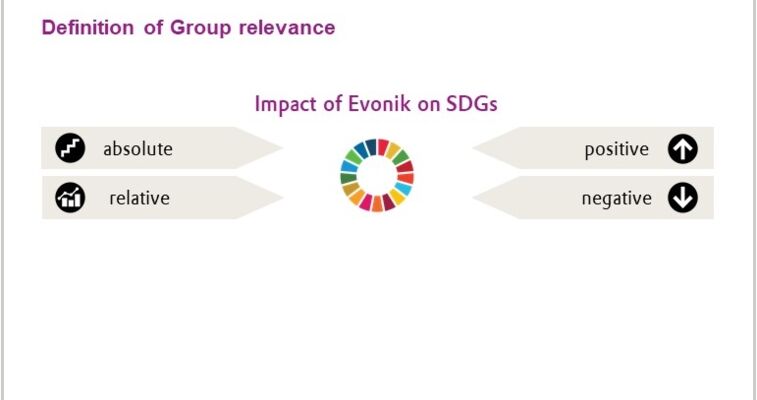
SDGs of relevance for Evonik
In fall 2015, the General Assembly of the United Nations adopted 17 Sustainable Development Goals (SDGs), which it aims to achieve by 2030 through a collaborative partnership between governments, industry, and society.
For a number of years Evonik is intensely dealing with the SDGs. In 2017, we therefore started to systematically examine and present the contribution made by our products to achieving the SDGs. In the course of this, it became clear that many of our products with distinct sustainability benefits are also clear growth drivers.
In 2018 we have developed our own methodology based on qualitative and quantitative criteria supporting us to identify the most relevant SDGs for the Group.
In this context, we paid special attention to the sub-targets of the 17 SDGs. A SDG is relevant for us if there is a significant positive or negative influence on or by Evonik. For the businesses defined at the Product-Application-Region-Combination (PARC) level, we have determined the positive and negative impacts along the value chain. In a multi-step process, the relevant PARCs are weighted on the basis of sales and corporate strategy (inclusion in our growth engines and innovation growth fields). We also take account of the views of our external stakeholders and the results of our materiality analysis.
This evaluation resulted in the ranking of the SDGs you find on top of this page.The ranking has the following order:
- Responsible Consumption and Production
- Climate Action
- Good Health And Well-Being
- Clean Water And Sanitation
Read more about the Evonik method:

What do we mean by relevant for Evonik?
A SDG is considered relevant for Evonik if there is a significant positive or negative effect on or by Evonik. That influence may be either absolute or relative (i.e., compared with the influence of an established alternative product).

We have developed a multi-step weighting process to determine Evonik's influence. Our entire portfolio has been divided into product-application-region combinations (PARCs) (framework WBCSD). We have analyzed the value chains for these PARCs (upstream, gate-to-gate, downstream) in relation to the SDGs and their sub-targets to see whether there is any positive, neutral or negative influence on or by Evonik. PARCs that influence the SDGs along the value chain and are part of one of Evonik's growth engines or innovation growth fields were also taken into account for each of the SDGs.

Other criteria used in this process were the significance of the SDGs for key Evonik stakeholders and the results of our materiality analysis.

From this analysis, we have derived the four most important SDGs for Evonik:
- SDG 12 Responsible consumption and production
- SDG 13 Climate action
- SDG 3 Good health and well-being
- SDG 6 Clean water and sanitation
More than 80 percent of our sales already make a positive contribution to achieving the SDGs and around 60 percent have a positive effect on the four SDGs identified as being particularly relevant for Evonik.
